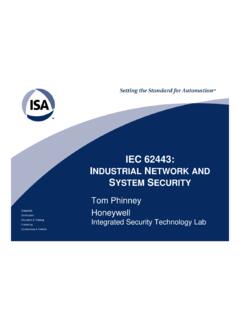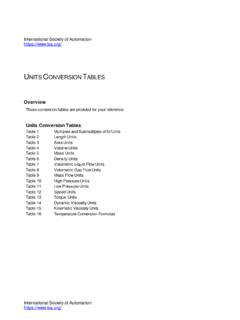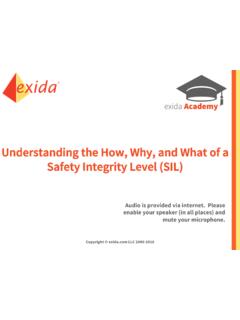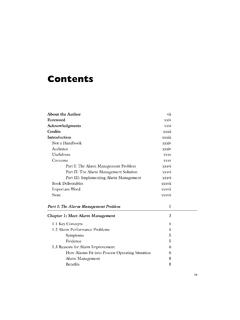Transcription of Understanding and Applying the ANSI/ ISA 18.2 Alarm ...
1 Understanding and Applying the ansi /. ISA Alarm Management Standard Abstract Alarm Management has become an ever-increasing topic of discussion in the power and processing industries. In 2003, ISA started developing a standard around this subject. After six years of hard work, the Management of Alarm Systems for the process Industries standard was published. This paper reviews the scope, regulatory impact, requirements, recommendations, Alarm definitions, and other details of the standard. Overview In this white paper, we will review the most Over the last several years, Alarm management has important aspects of the scope, requirements, become a highly important topic, and the subject recommendations, and other contents of ISA- of a number of articles, technical symposia, and However, there is no substitute for obtaining books.
2 And Understanding the full document. In 2003, ISA began developing an Alarm 1. Purpose and Scope management standard. Dozens of contributors, The basic intent of is to improve from a variety of industry segments, spent safety. Ineffective Alarm systems have often been thousands of hours participating in the documented as contributing factors to major development. PAS participated as both a section process accidents. The Alarm system problems editor and a voting member. After six years of that addresses have been well known for work, the new Management nearly two decades. of Alarm Systems for the process Industries There are several common misconceptions about ( ) standard was released.
3 It is available at standards. Standards intentionally describe the minimum acceptable and not the optimum. By The issuance of is a significant event design, they focus on the what to do rather for the chemical, petrochemical, refining, than the how to do it. By design, standards do power generation, pipeline, mining and metals, not have detailed or specific how-to guidance. pharmaceutical, and similar industries using does not contain examples of specific modern control systems with Alarm functionality. proven methodologies or of detailed practices. It sets forth the work processes for designing, The standard focuses on both work process implementing, operating, and maintaining a requirements ( shall ) and recommendations modern Alarm system in a life cycle format.
4 It will ( should ) for effective Alarm management. also have considerable regulatory impact. Readers familiar with Alarm management is quite different from the usual ISA literature should not expect to learn new or standard. It is not about specifying communication different information when reading the protocols between equipment, nor the detailed The key difference is that is a standard, design of control components. It is about the not a guideline or a recommended practice, and work processes of people. Alarm management it was developed in accordance with stringent is not really about hardware or software; it is ansi methodologies. As such, it will be regarded about work processes.
5 Poorly performing Alarm as a recognized and generally accepted good systems do not create themselves. engineering practice (RAGAGEP) by regulatory is a comprehensive standard developed per agencies. is in the process of being stringent methods based on openness, balancing adopted as an International IEC standard (IEC. of interests, due process , and consensus. These 62682 Ed. )1. components make it a recognized and generally The committee is now working on accepted good engineering practice from a creating additional explanatory and methodology regulatory point of view. information in follow-up ISA technical reports. These should be available in 2011. 1. See &Pu=62682&Pa=&Se=&Am=&Fr=&TR=&Ed= PAS 2010 1.
6 2. Does Apply to You? The important thing is that regulatory agencies The focus of is on Alarm systems that have general duty clauses and interpretations. As are part of modern control systems, such as one example, consider OSHA (d)(3) (ii). DCSs, SCADA systems, PLCs, or Safety Systems. which states, The employer shall document that It applies to plants with operators responding to equipment complies with recognized and generally alarms depicted on a computer-type screen and/ accepted good engineering practices. This is or an annunciator. actually a regulatory acronym, RAGAGEP. This includes the bulk of all processes operating Codes, standards, and practices are usually today, specifically: considered recognized and generally accepted good engineering practices.
7 In the OSHA. Petrochemical interpretation letter to ISA, a National Consensus Chemical Standard, such as , is a RAGAGEP. Refining OSHA recognizes ANSI/ ISA as Platform an There exists a Memorandum Pipelines of Understanding between OSHA and ansi . Power Plants regarding these Pharmaceuticals Mining & Metals There is little question is an example of RAGAGEP, and companies should expect Additionally, it applies whether your process is the regulatory agencies to take notice. Generally, continuous, batch, semi-batch, or discrete. The a regulated industry can be expected to either reason for this commonality is that Alarm response comply with RAGAGEP or explain and show is really not a function of the specific process being they are doing something just as good or better.
8 Controlled; it is a human-machine interaction. The Indeed, OSHA has sought and received permission steps for detecting an Alarm , analyzing the situation, from ISA to internally distribute to its and reacting are steps performed by the operator. inspectors. This was with the specific intent to be There is little difference if you are making (or able to easily cite it in investigations and used for moving) gasoline, plastics, megawatts, or aspirin. enforcement reasons. While many industries feel We're different! , that is simply not the case when it comes to Alarm The Chemical Safety Board ( ). response. Many different industries participated will also be using as a resource in its in the development of , recognized investigations.
9 Other regulatory agencies are also this, and the resulting standard has overlapping becoming aware of The American applicability. Petroleum Institute (API) will soon release API. RP-1167, Alarm Management Recommended indicates the boundaries of the Alarm Practices for Pipeline Systems. This API document system relative to terms used in other standards, is in full alignment with , and the Pipeline such as Basic process Control System (BPCS), and Hazardous Materials Safety Administration Safety Instrumented System (SIS), etc. Several (PHMSA) generally adopts API recommended exclusions are listed to not contradict existing practices in their regulatory language. content in other standards.
10 4. Grandfathering 3. Regulatory Impact A grandfather clause used by other ANSI/ ISA. This paper is not intending to be a detailed clause- standards was also used in It is: by-clause interpretation of OSHA, EPA, DOT, PHMSA, or other regulations. The regulatory For existing Alarm systems designed and constructed in environment is complex and overlapping for accordance with codes, standards, and/or practices prior some industry segments. Many industries are to the issue of this standard, the owner/operator shall clearly covered by OSHA process determine that the equipment is designed, maintained, Safety Management, which makes a few specific inspected, tested, and operated in a safe manner.









